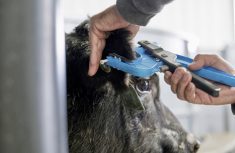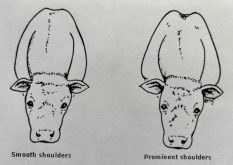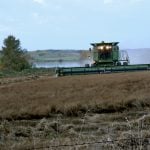For cattle producers in the United States, focusing on their genetics just got a lot easier.
In early May, National Beef Packing Co., in collaboration with the American Angus Association, announced new premiums for cattle based on their genetic merit scorecards.
The premiums use a U.S. Premium Beef value-based grid which previously rewarded cattle that excelled in carcass quality. Now, producers can be rewarded for their genetics on the same grid.
Read Also

What to know before you go to Agribition 2025
If you’re attending Agribition 2025, this is the place to find out about tickets, dates and what’s happening this year.
Troy Marshall, director of commercial industry relations with the American Angus Association, says it’s exciting because it’s the first time they’ve seen genetic merit rewarded in a grid scenario, in addition to the performance of cattle. He adds they want to reward producers and send the right message for investing in genetics.
Marshall says the idea emerged while discussing how to boost beef demand with American consumers. He says there is a lot of opportunity for American producers with this program — and maybe some for Canadian producers, as well.
AngusLink Genetic Merit Scorecard
How much producers will get for the grid premium depends on what their score is on the AngusLink Genetic Merit Scorecard. According to the AngusLink website, the scorecard is often used by buyers to select cattle. It comprises three different scores between 0 and 100. The higher the score, the better the genetics. The three scores are for separate grid and feedlot performance scores, as well as the combination of both to create the beef score. Scores are assigned based on the bulls that appear in the calf crop and the dollar value indexes.
The grid premium will start for cattle harvested after August 5 and will be US$5 for cattle with a score of 100 or greater. This is for cattle marketed exclusively through U.S. Premium Beef and delivered to the National Beef Packing plants in Liberal and Dodge City, Kansas.
Then, a second grid premium starts December 1 for cattle scoring 150 and up. The producer will receive a US$10 premium. Cattle scoring between 100 and 149 will still receive a $5 premium.
“The only cost of the program is the cost of doing an age and source verification. The actual scorecard part is free. And they just need a list of their buyers that they use and a simple questionnaire. We kind of get some cow herd and historical information, too. But essentially, if they know what bulls sired those calves, they can participate in the program. So, it’s simple to use and a really good return on investment,” says Marshall.
The genetic merit scorecard was introduced in 2021 to calculate the genetic potential of feeder cattle. Marshall says in 2023 they saw a 400 per cent increase in the use of the scorecard itself and believes they are at the tipping point to broader industry adoption. He hopes to see wider adoption with the grid premium as well, as the scorecard is implemented in the premium.
Investing in genetics
Marshall says grid premiums are one of the first of their kind being offered to producers. He says these premiums are the next step in value-based marketing, whether they’re for certified Angus beef, quality grades or carcass weights.
“They’ve kind of paid based off those, but it’s really the first time where we’ve seen that premium being paid for genetic merit.”
He says it is important to reward producers for their genetics because those genetic investments help improve the quality overall of the American cattle herd. Plus, the commodity pricing system forces everyone towards the average. The grid premium encourages competition and improves the quality of beef overall, which drives demand.
He says because of this, the grid premiums benefit not just producers but the rest of the industry.
“Now, we’re kind of looking at things more from a total systems approach and realizing that if we send the right signals, producers will respond.”
Canadian perspective
Marshall says he expects to see Canadian organizations offering something similar in the future.
“From a Canadian perspective, while those grids are being offered at the plants in Kansas with National there, there’s quite a bit of distance there. But I think it’s probably an indication of what we’re going to see where hopefully other packers and other groups begin to adopt kind of a similar type process there, where they try to reward those who are investing in better genetics. It’s kind of exciting from that standpoint.”
When asked if Canadian producers can be eligible for this grid premium if their cattle end up south of the border, Marshall says there is potential for that. He says they have had Canadian sires in their programs. If they can compare the Canadian and American sires on an equal basis, they should be able to be included.
“We’re so interrelated. A lot of those calves in Canada are being marketed in the U.S. or fed in the U.S. and vice versa going both directions. And so I do think there’s opportunity for that program, especially for the cattle that are being exported to the U.S. And ultimately, hopefully, as the program grows, we’ll see more and more cattle in Canada as well.”
In an email, Canadian Angus Association CEO Myles Immerkar writes that grid premium programs are more common in the U.S. than Canada because the majority of cattle in the U.S. are sold on some type of grid-based program.
“It is one new program from one company, but one can certainly appreciate that they are recognizing the importance of genetics and the genetic performance prediction tools available when it comes to the finished product and that is what is being rewarded with this marketing campaign,” Immerkar says.
He does see opportunity for something like this in the Canadian market as the industry changes.
“As supply chains become more integrated, there will be evolution to how cattle are bought and how cattle are incentivized in Canada as well. It may be similar type of programs, versions of this program, or something entirely new.”
Future
With the grid premiums about to start rolling out in America this summer, Marshall says they have had a positive response from producers since the announcement.
“I couldn’t put any metrics on it, to be honest with you, except for that the amount of phone calls and interest we’ve had has been phenomenal. So it’s been really exciting.”
He expects to see more grid premiums based on genetic merit pop up — not just in the United States but all over. With this premium the first of its kind in the market, Marshall says he hopes this causes others in the industry to prioritize genetics, as well.
“I just think it’s a big step forward in terms of rewarding producers for the investment they’re making in their genetics.”

















